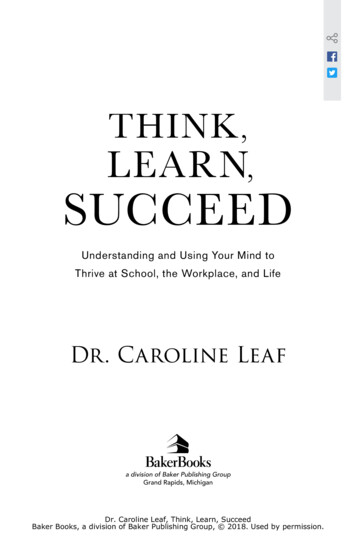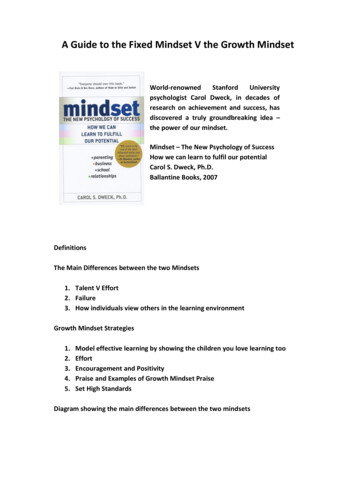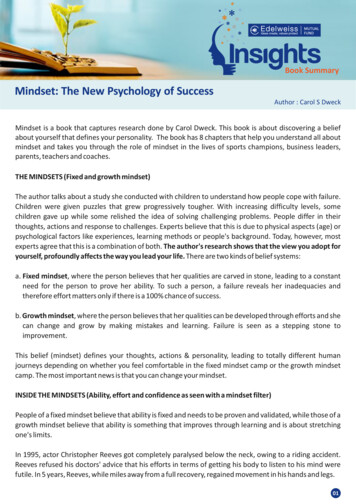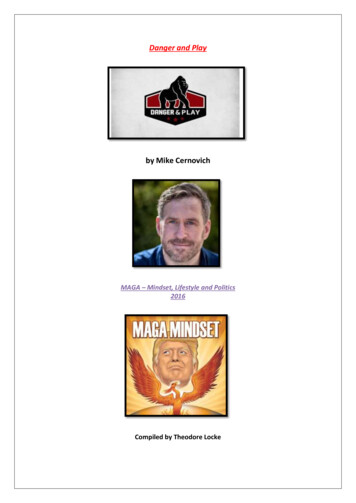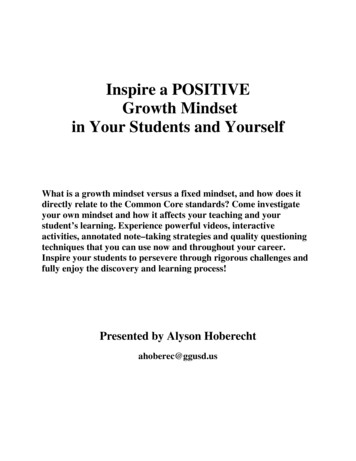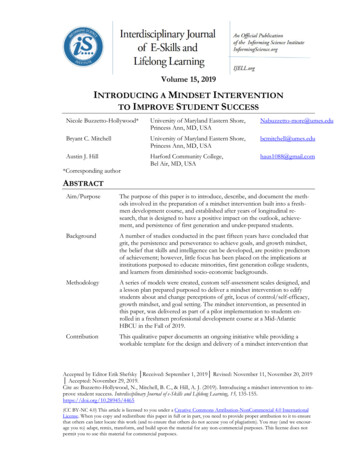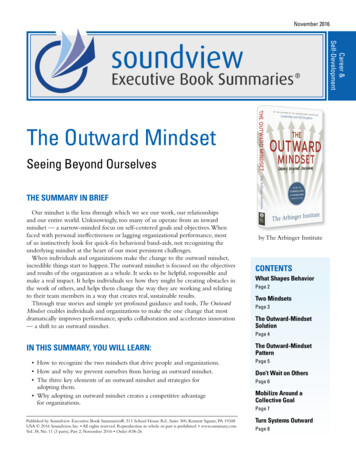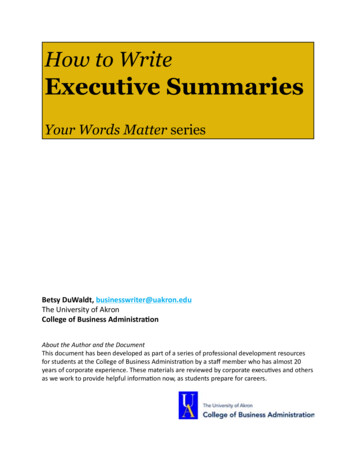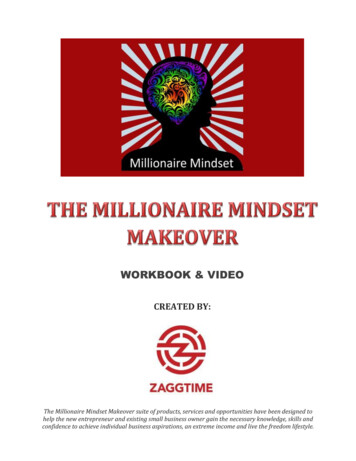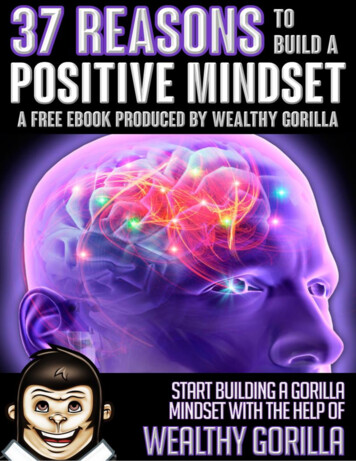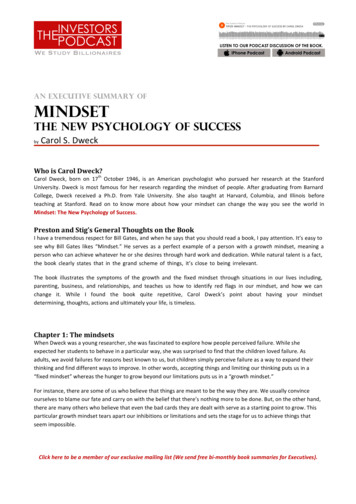
Transcription
LISTEN TO OUR PODCAST DISCUSSION OF THE BOOK.An Executive Summary ofMINDSETTHE NEW PSYCHOLOGY OF SUCCESSbyCarol S. DweckWho is Carol Dweck?thCarol Dweck, born on 17 October 1946, is an American psychologist who pursued her research at the StanfordUniversity. Dweck is most famous for her research regarding the mindset of people. After graduating from BarnardCollege, Dweck received a Ph.D. from Yale University. She also taught at Harvard, Columbia, and Illinois beforeteaching at Stanford. Read on to know more about how your mindset can change the way you see the world inMindset: The New Psychology of Success.Preston and Stig’s General Thoughts on the BookI have a tremendous respect for Bill Gates, and when he says that you should read a book, I pay attention. It’s easy tosee why Bill Gates likes “Mindset.” He serves as a perfect example of a person with a growth mindset, meaning aperson who can achieve whatever he or she desires through hard work and dedication. While natural talent is a fact,the book clearly states that in the grand scheme of things, it’s close to being irrelevant.The book illustrates the symptoms of the growth and the fixed mindset through situations in our lives including,parenting, business, and relationships, and teaches us how to identify red flags in our mindset, and how we canchange it. While I found the book quite repetitive, Carol Dweck’s point about having your mindsetdetermining, thoughts, actions and ultimately your life, is timeless.Chapter 1: The mindsetsWhen Dweck was a young researcher, she was fascinated to explore how people perceived failure. While sheexpected her students to behave in a particular way, she was surprised to find that the children loved failure. Asadults, we avoid failures for reasons best known to us, but children simply perceive failure as a way to expand theirthinking and find different ways to improve. In other words, accepting things and limiting our thinking puts us in a“fixed mindset” whereas the hunger to grow beyond our limitations puts us in a “growth mindset.”For instance, there are some of us who believe that things are meant to be the way they are. We usually convinceourselves to blame our fate and carry on with the belief that there’s nothing more to be done. But, on the other hand,there are many others who believe that even the bad cards they are dealt with serve as a starting point to grow. Thisparticular growth mindset tears apart our inhibitions or limitations and sets the stage for us to achieve things thatseem impossible.Click here to be a member of our exclusive mailing list (We send free bi-monthly book summaries for Executives).
Even Tolstoy and Darwin weren’t considered extraordinary as children.Many experts assert that a child’s IQ determines whether he/she is going to be successful or not; however, instead offalling into a fixed mindset by relying on the IQ, it’s best to develop a growth mindset that offers more opportunities.At the end of the day, people with fixed mindsets tend to avoid risks, but they also fail since they don’t believe in anyeffort. Contrastingly, the ones with growth mindsets remain resilient, confront risks, and thrive even in toughcircumstances.Chapter 2: Inside the mindsetsThe beauty of our mindset is that it can be changed. Even if you recognize that you have a fixed mindset, you can dobetter by converting it to a growth mindset. Remember that when you embrace a particular mindset, things changedrastically, which is akin to entering a new world. While a fixed mindset indicates that success is all about constantlyvalidating yourself, a growth mindset gives you the leniency to stretch yourself and learn more. It’s never too late tolearn anything no matter how old you are. Intelligence isn’t a trait we possess when we are born; in fact, it’s a skillthat’s honed as time goes by.To evaluate whether you have a fixed or a growth mindset, imagine that you have an option to solve an easy or atough puzzle. If you play safe and choose the easy one, you’re limiting your ability to learn, but on the other hand, ifyou’re all excited and ready to take a tough challenge you’re already on the right path because you’re allowingyourself to learn. The moment you stop doing things to prove yourself, you shed your fixed mindset and enter thegrowth mindset where you aren’t afraid of making mistakes.So, how do you get rid of the fear of making mistakes? Imagine a toddler. He simply starts crawling and begins to walkone day. He isn’t bothered about what anybody would think of him. Similarly, you have to stop thinking about othersjudging you. It’s okay to make mistakes and correct them rather than completely avoiding it.Chapter 3: The truth about ability and accomplishmentOf all the myths surrounding achievements and abilities, the most common one is that success is instantaneous. Forinstance, almost everyone thinks that Thomas Edison invented the light bulb out of the blue while tinkering alone inhis laboratory. But, the truth is far different. Not only did he have assistants toiling around him, but it took years andyears of hard work for him to get anywhere. Success doesn’t suddenly drop into your lap – the reality is that it takes alot of hard work.When Dweck measured the mindsets of children that were transitioning to high school, she realized that althoughboth sets of children with fixed and growth mindsets had the same grades earlier, the ones with the fixed mindsetsbegan to get worse. They had their own excuses that ranged from blaming themselves to the teacher. While theirgrades fell, the growth mindset children began to excel. Even when they did poorly in a few tests, they bounced backimmediately.So, what was the difference between the two sets of children? Well, there are many, but the most notable one is theeffort. The fixed mindset children tried their best NOT to put any effort since they wanted their work to be as simpleas possible. When faced with tough homework, they only memorized it as a way of preparation for the exam;however, on the other hand, the growth mindset children were more interested to understand and learn theirmistakes so that they could push forward. Similarly, a big difference between growth and fixed mindset is that whilethe growth mindset takes charge of learning, the fixed mindset will do everything other than exerting some effort tobe successful, and this yearning to learn more is the secret ingredient of success that sets the people with growthmindset apart.Click here to be a member of our exclusive mailing list (We send free bi-monthly book summaries for Executives).
Chapter 4: Sports: The mindset of a championIn sports, the consensus is that the one who’s naturally talented will always win. Most coaches don’t even bother tofind out if the athlete can work hard because they judge players on their “natural ability.” This ability makes theplayers unable to accept their deficiencies; in fact, they are terrified of their shortcomings because they feel that theirnatural talent needs no effort. But, what they don’t realize is that talent is not as important as the mindset.Take the example of one the greatest boxers in history. Muhammad Ali was never a natural. Not only did he fail themeasurements that determined the physique of a fighter, but he wasn’t naturally built to be a boxer. On the otherhand, Sonny Liston had it all. His moves were perfect, and he was meant to win. However, Ali beat Liston, and thematch is most remembered even today. All the odds were stacked against Ali, but he managed to win. How did he doit? Again, the answer is in his mindset. He did his homework by understanding everything about Liston and used itagainst him. Perhaps, his boxing ability was second to Liston, but his perfectly working brain and mindset gave him theedge against Liston. The proof is all there, but we still refuse to see it.Chapter 5: Business: Mindset and leadershipWhen the corporate giant Enron crumbled in 2001, the world was shocked. They had the best talent and paid bigbucks for it, yet they were defeated. Just like the sports industry, Enron had created a legacy of hiring people whowere naturals in business. These “naturals” they hired were so terrified of appearing inadequate that they failed tolearn more. Not only did they not bother to correct their mistakes, but they continued with the same mindset untilEnron diminished.Today, a fixed mindset continues to plague employees in companies. Never mind the employees, even the CEO tendsto have a similar mindset. For instance, when Jim Collins and his team embarked on a 5-year study to take a look atwhy some companies became great, and others didn’t, the results spoke for themselves.It was spectacular to note that the leaders of the companies made all the difference. These leaders weren’t pompouspeople who advertised themselves, but they were hard-working and believed in their work. Their growth mindset iswhat separated them from the rest of the lot. It’s not that they didn’t face challenges – of course, it was a tough jobfor them too – but what made them great leaders is that they accepted their mistakes and did their best to correctthem and grow further. Their will to improve set the stage for them. Therefore, even if you make mistakes, rememberthat it is okay, but the only way to succeed is to learn from those mistakes and not repeat them in the future.Chapter 6: Relationships: Mindsets in love (or not)The right mindset is critical not only for a successful career, sports, or education, but it plays a big role in relationshipstoo. It’s inevitable to face rejection and sadness when it comes to relationships; however, the way we handle itmatters a lot. While fixed mindset people refuse to correct their wrongdoings and accept the reality, they tend to leantowards revenge. They usually feel judged and unloved and ultimately resent everything as feelings bottle up.A stark contrast is highlighted with the growth mindset people. As humans, they also face rejection, but instead ofblaming the other individual, they choose to accept it and move on. As soon as they let go of all of the pain, they comeout stronger and ready to face the world. An important distinction between the two mindsets is noted mainly in thebehavior. Since a fixed mindset provides no opportunity to heal wounds, they get stuck in a rut and prevent furthersatisfying relationships. However, a growth mindset allows an individual to forget and carry on with their lives.Click here to be a member of our exclusive mailing list (We send free bi-monthly book summaries for Executives).
Chapter 7: Parents, teachers, and coaches: Where domindsets come from?Every parent wants to see his/her child succeed because there’s nothing more satisfying than participating in yourchild’s development. Understandably, you want to encourage your child to excel, but have you ever thought about thefact that you could actually be pushing them towards a fixed mindset? For instance, if you constantly praise your childabout how smart he is, he might think that he has to prove himself every time. Constant judgments and labels willonly make him worry more, and if he doesn’t succeed, he might make the same mistake as others and think that he’sfit for nothing.The more you tell your kid to be intelligent or smart or witty, the more she will be obsessed with it. Unknowingly,you’re harming your child’s intelligence and ability to perform by harping on his skill sets now and then. Of course,kids will be kids, and they will always bask in glory when you praise them, but as an adult, you need to remember thata momentary praise can hamper their mindsets more than you can ever imagine. Therefore, instead of searching forperfection, teach your child to love challenges, accept failure, learn, improve, and make mistakes because that willonly sharpen their skills.Chapter 8: Changing mindsetsThe best part of a mindset is that you can change from a fixed to a growth mindset with some effort. By askingyourself a few questions, you can determine whether you have a growth or a fixed mindset. Remember not to judgeyourself harshly because growth mindset doesn’t encourage you to label yourself in any way. On the contrary, itallows you to explore your own mistakes and correct them.Also, there’s no such thing as natural talent. A writer, athlete or a businessman can’t be successful if he relies only onhis apparent talent. For instance, we don’t laugh at babies when they don’t understand anything. We rightly observethat they need more time to understand and make sense of things, so why do we laugh at others when they are stilltrying to learn something?The problem with the fixed mindset is that it traps you with no way out. The more you feel like you have to proveyourself, the more you detest challenges and ultimately place the blame on something or someone else. Therefore,try to change your mindset into a growth mindset and see how it can impact your life. Yes, change can be hard, but itcan also be easy if you start afresh and work at it earnestly.Click here to be a member of our exclusive mailing list (We send free bi-monthly book summaries for Executives).
Read Reviews forMINDSETon AmazonLISTEN TO OUR PODCAST DISCUSSION OFMINDSETon IPHONE oR on ANDROIDFreeExecutive summariesSign-up for our mailing list ofwww.TheInvestorsPodcast.com/email-list/Click here to be a member of our exclusive mailing list (We send free bi-monthly book summaries for Executives).
An Executive Summary of MINDSET THE NEW PSYCHOLOGY OF SUCCESS by Carol S. Dweck Who is Carol Dweck? Carol Dweck, born on 17th October 1946, is an American psychologist who pursued her research at the Stanford University. Dweck is most famous for her r
